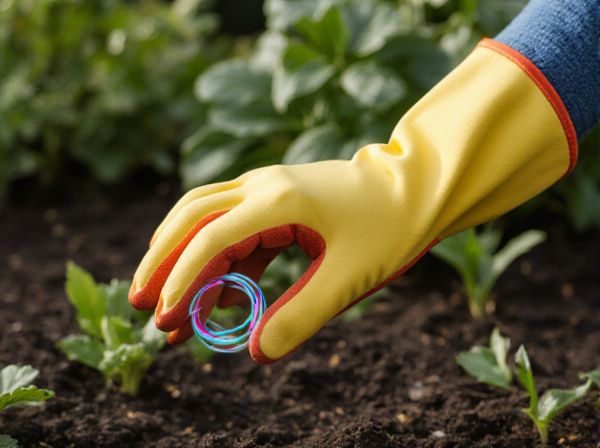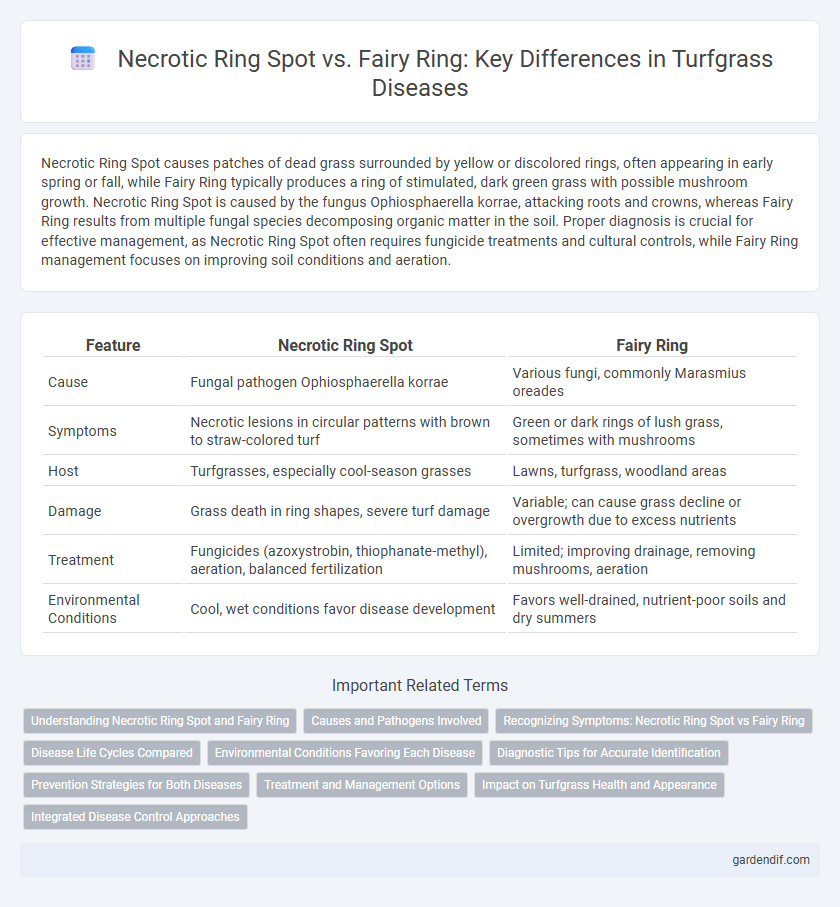
Necrotic Ring Spot vs Fairy Ring Illustration
Necrotic Ring Spot causes patches of dead grass surrounded by yellow or discolored rings, often appearing in early spring or fall, while Fairy Ring typically produces a ring of stimulated, dark green grass with possible mushroom growth. Necrotic Ring Spot is caused by the fungus Ophiosphaerella korrae, attacking roots and crowns, whereas Fairy Ring results from multiple fungal species decomposing organic matter in the soil. Proper diagnosis is crucial for effective management, as Necrotic Ring Spot often requires fungicide treatments and cultural controls, while Fairy Ring management focuses on improving soil conditions and aeration.
Table of Comparison
| Feature | Necrotic Ring Spot | Fairy Ring |
|---|---|---|
| Cause | Fungal pathogen Ophiosphaerella korrae | Various fungi, commonly Marasmius oreades |
| Symptoms | Necrotic lesions in circular patterns with brown to straw-colored turf | Green or dark rings of lush grass, sometimes with mushrooms |
| Host | Turfgrasses, especially cool-season grasses | Lawns, turfgrass, woodland areas |
| Damage | Grass death in ring shapes, severe turf damage | Variable; can cause grass decline or overgrowth due to excess nutrients |
| Treatment | Fungicides (azoxystrobin, thiophanate-methyl), aeration, balanced fertilization | Limited; improving drainage, removing mushrooms, aeration |
| Environmental Conditions | Cool, wet conditions favor disease development | Favors well-drained, nutrient-poor soils and dry summers |
Understanding Necrotic Ring Spot and Fairy Ring
Necrotic Ring Spot and Fairy Ring are fungal diseases affecting turfgrass, with Necrotic Ring Spot caused by Ophiosphaerella korrae leading to chlorotic and necrotic lesions in cool-season grasses like Kentucky bluegrass. Fairy Ring, resulting from various basidiomycete fungi such as Marasmius oreades, produces distinctive rings of healthy, dark green grass or mushrooms, often in warm-season grasses. Identifying the specific fungal pathogen and symptoms is crucial for effective disease management and turf recovery.
Causes and Pathogens Involved
Necrotic Ring Spot is caused primarily by the soilborne fungus Ophiosphaerella korrae, which attacks grass roots leading to needle-like necrotic lesions. Fairy Ring is associated with basidiomycete fungi such as Marasmius oreades or Lycoperdon spp., which decompose organic matter in the soil creating visible rings of mushroom growth. Both diseases disrupt turf health but involve distinct fungal pathogens and modes of infection.
Recognizing Symptoms: Necrotic Ring Spot vs Fairy Ring
Necrotic Ring Spot causes circular patches of dead grass surrounded by diseased tissue, often appearing in cool, moist conditions and showing brown or straw-colored rings with a necrotic center. Fairy Ring typically presents as dark green, lush rings or arcs on lawns, sometimes accompanied by mushrooms or fungal fruiting bodies, thriving in warm, dry environments. Identifying these unique symptom patterns is crucial for accurate diagnosis and appropriate treatment of each turfgrass disease.
Disease Life Cycles Compared
Necrotic Ring Spot and Fairy Ring diseases exhibit distinct life cycles influenced by environmental factors and host interactions. Necrotic Ring Spot, caused by the fungus Ophiosphaerella korrae, thrives in cool, moist soil and progresses through a saprophytic phase before invading turfgrass roots, leading to characteristic necrotic lesions. Fairy Ring, typically caused by various Basidiomycete fungi such as Marasmius oreades, develops through extensive mycelial growth that decomposes organic matter, creating visible rings and producing fruiting bodies during humid conditions.
Environmental Conditions Favoring Each Disease
Necrotic Ring Spot thrives in cool, moist soil conditions with poor drainage, typically occurring during spring and fall when soil temperatures range from 50 to 60degF. Fairy Ring favors warm, dry environments and often appears in summer when turfgrass is stressed by drought and high temperatures. Soils rich in organic matter and those with low compaction tend to promote Fairy Ring development, while Necrotic Ring Spot is more severe in compacted, low-pH soils.
Diagnostic Tips for Accurate Identification
Necrotic Ring Spot presents as irregular, sunken patches with dead grass, typically showing brown or yellowish lesions within cool-season turfgrass, whereas Fairy Ring manifests as circular or arc-shaped rings with lush, dark green grass or mushrooms at the edges. Accurate diagnosis relies on observing soil moisture levels--Necrotic Ring Spot often thrives in compacted, poorly drained soils, while Fairy Ring favors dry, hydrophobic conditions. Laboratory testing of soil and root samples can confirm the presence of pathogenic fungi specific to each disease, ensuring targeted treatment strategies.
Prevention Strategies for Both Diseases
Prevent Necrotic Ring Spot by improving soil drainage, reducing thatch buildup, and applying fungicides containing azoxystrobin or propiconazole during early spring. For Fairy Ring, aerate soil regularly, maintain balanced nitrogen levels, and use fungicides like chlorothalonil or flutolanil to suppress fungal growth. Both diseases benefit from proper lawn watering practices and avoiding excessive thatch to limit fungal proliferation.
Treatment and Management Options
Necrotic Ring Spot treatment involves improving soil drainage and aeration while applying fungicides like azoxystrobin during early symptom development; maintaining balanced nitrogen levels also helps reduce disease severity. Fairy Ring management focuses on disrupting fungal growth by aerating turf and using soil wetting agents to break hydrophobic layers, with fungicidal treatments such as thiophanate-methyl applied when visible rings appear. Integrated disease management combining cultural practices and targeted fungicide applications effectively controls both Necrotic Ring Spot and Fairy Ring in turfgrass.
Impact on Turfgrass Health and Appearance
Necrotic Ring Spot causes irregular yellow or brown patches, leading to severe turfgrass thinning due to root and crown tissue decay, significantly impacting turf density and health. Fairy Ring manifests as circular dark green or brown rings with potential mushroom growth, affecting turfgrass appearance by altering soil moisture and nutrient dynamics rather than causing root damage. Both diseases reduce aesthetic quality, but Necrotic Ring Spot poses a greater threat to turfgrass vitality, requiring targeted management for restoration.
Integrated Disease Control Approaches
Integrated disease control approaches for Necrotic Ring Spot and Fairy Ring involve combining cultural practices, resistant turfgrass cultivars, and targeted fungicide applications. Maintaining proper soil nutrition and aeration reduces disease severity by promoting healthy root growth and microbial balance. Regular monitoring and timely interventions based on disease development cycles enhance the effectiveness of management strategies.
Necrotic Ring Spot vs Fairy Ring Infographic

 gardendif.com
gardendif.com